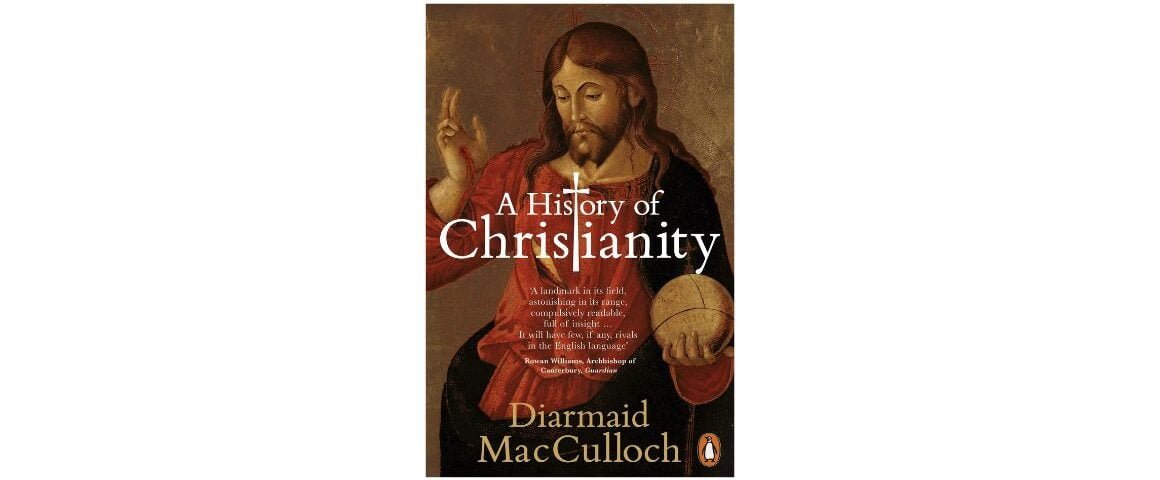Christianity: The First Three Thousand Years. By Diarmaid MacCulloch. London, England: Penguin Books, 2009. 1184 pp. $32.00 (paper).
The average Christian immediately interjects, “Wait, Christianity is not 3,000 years old.” Where does this story start? Clearly, Diarmaid MacCulloch intends to lay some groundwork for what Christians know and practice in the present day. This impressive volume, at over 1,000 pages of chapter text, has a lot to say about this story.
The reader must first understand something about Diarmaid MacCulloch. He has a history with the Church of England. MacCulloch achieved ordination to the diaconate in that church before eventually taking leave of organized Christianity, though he describes himself as “a friend of Christians.” MacCulloch was trained in the liberal tradition of academia and is a homosexual. All of these elements of who he is color the material. And MacCulloch is not afraid to make judgments and interpret the stories according to his presuppositions.
These presuppositions include a general tendency to view scientists as sympathetic figures and ecclesiastical authorities as scoundrels. Another is that every heresy comes back around. This leads him to question whether it was heresy in the first place, if it never truly goes away. Of course, all of this points to a subjective view of truth.
Most readers are daunted by undertaking a tome of this length. (I was diverted for extra security screening at an airport for having the book in my carry-on bag. TSA couldn’t figure out what it was on the X-ray scanner.) To make the material manageable, it would be better to view it as a corpus of five separate books compiled together.
With a five-part approach the material becomes:
I. A Millennium of Beginnings and One Church, One Faith, One Lord? (1000 BCE–451 CE)
II. Vanishing Futures: East and South and The Unpredictable Rise of Rome (451–1300)
III. Orthodoxy: The Imperial Faith (451–1800)
IV. Western Christianity Dismembered (1300–1800)
V. God in the Dock (1492–Present)
This deviates slightly from MacCulloch’s own outline of the material, but it breaks down into manageable blocks of approximately 200 pages. I would suggest the non-academic reader take a break between groupings and read something else. Otherwise, the material will become both repetitive and confusing. MacCulloch has not attempted to write his story in a strictly linear chronological order – there’s too much material for that. Instead, the reader is told parts of the story based on geographical relevance. Of course, after the introduction of modern printing and the explorations of the Age of Discovery, the world opened up and the final segment of the story is told within a more globalized context.
MacCulloch uses the broad category of “Semitic religion” as a backdrop to the narrative. To him, Semitic religion is characterized by two basic tenets: immortality and Divine intervention. Semitic religion can thus include the three great Monotheistic traditions: Judaism, Christianity, and Islam. However, MacCulloch avoids the pitfall of assuming these three agree in one basic witness.
MacCulloch makes a couple of observations which bring clarity to the overall picture of the material on p. 770:
Behind the story of European Enlightenment, which is sometimes told as a fairy-tale progression from Christian (and clerical) shortsightedness to a secularized clarity of vision, there lies a more interestingly complex narrative in which religion and doubt, blasphemy and devotion remained in dialogue, as they had done throughout Christian history…
Amid the theological storms which fractured the Western Latin Church are repeated glimpses of other eddies of ideas which disrupted the assumptions of medieval Europeans about the world around them.
The strength of the book is generally good story-telling. This is not merely a collection of names, dates, and facts. MacCulloch also gives sufficient, but not excessive, attention to the political and social contexts within which these religious events unfold. This attention to detail manifests early, as MacCulloch takes care to discuss not only the Jewish roots of Christianity but the influences of the Greco-Roman world on the story of the church. MacCulloch has compiled much more research on topics like Oriental Orthodoxy and the Church of the East than most other comprehensive church histories.
Weaknesses include his obsession with finding women and homosexuals leading or at least driving the events he writes about. He is sympathetic to most every group that was branded heretical. Sometimes these two tendencies coalesce into conclusions such as labeling Perpetua a Montanist saint (162). With typical British ambivalence, his coverage of trends within the North American church is short and less thorough than is desirable.
Who should read this book? The serious student of church history. For the casual reader, it is too much to undertake. That reader would be better served by a more concise volume. Even clergy would probably be best served to approach this as a reference work wherein only those passages of particular relevance to some question at hand are read. But I felt a sense of achievement when I finished the whole thing.






'Book Review: “Christianity: The First Three Thousand Years”' has 1 comment
December 12, 2024 @ 3:24 pm Juha Mikkonen
Hello there!
Thank you for this review! It was very helpful. I have not read this book. I only wached BBC documentary by Diarmaid MacCulloch.